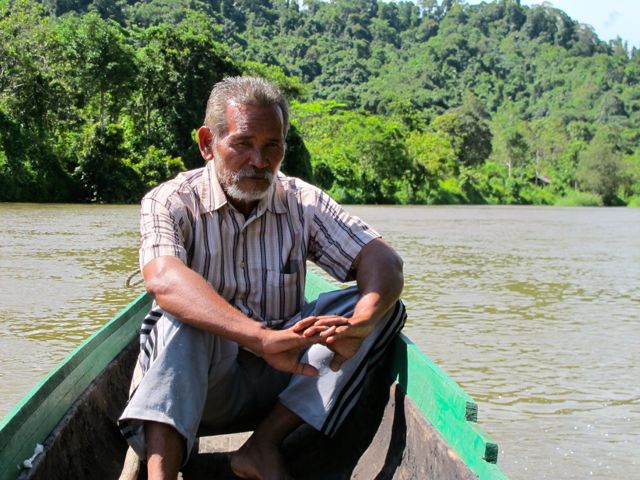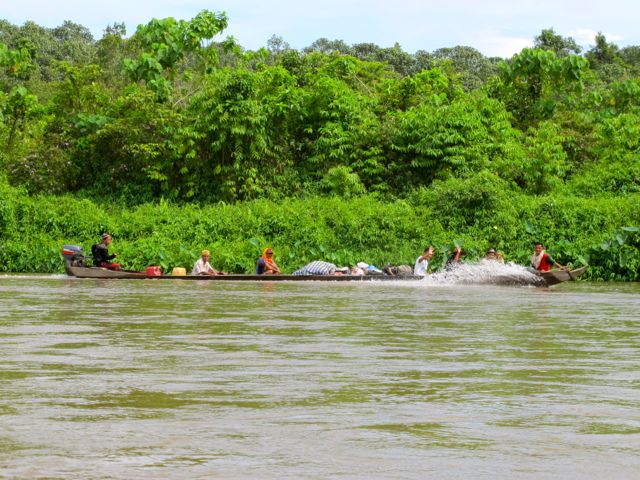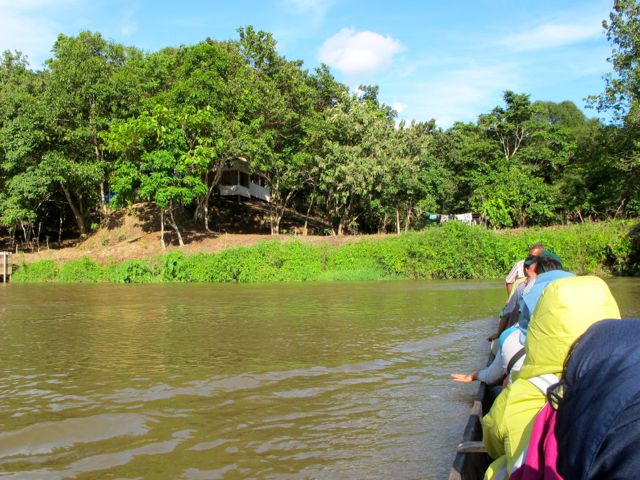- In Aceh Jaya, one of the regencies hit hardest by the tsunami that struck Sumatra in 2004, villagers have worked to conserve the forest in the vicinity of the Krueng Sabee River.
- They had to contend with illegal loggers lured by the immense demand for wood in the reconstruction period.
- With NGO assistance, local people planted thousands of coffee, durian, rambutan, jaloh and jabon tree saplings near the river’s headwaters.
Abdullah Rajab is not young. He has a shock of white hair. And when he laughs, it’s clear that many of his teeth are missing. But whenever a youngster asks about preserving the Krueng Sabee River, this 65-year-old brings to the discussion a rare focus and intensity.
The 30-kilometer-long Krueng Sabee is located in the eponymous subdistrict of Aceh Jaya – one of the regencies hit hardest by the tsunami that struck Sumatra on December 26, 2004. Infrastructure was damaged. Thousands of people died or went missing. Little beachfront was left. The only segment of the regency saved from disaster were the thick, forested hills of Bukit Barisan. It is this forest that Rajab and the Krueng Sabee River Forum he established in 2008 want to preserve.
Year by year, Rajab has watched silt fill the stretch of the Krueng Sabee that winds past his house in Bunta village. During the rainy season Bunta and other villages along the river’s banks get floods. Rajab credits the murk and floods to soil erosion near the river’s headwaters. “We know that the forests have all been cut – people take wood from that region indiscriminately,” he told Mongabay.
The forest the Krueng Sabee River Forum considers its jurisdiction spans 500 hectares. It is home to elephants, tigers, honey bears, long-tailed monkeys, gibbons, langurs and various bird species. Rajab recalled that in the 1970s – when he first set foot in the river shortly after moving to Bunta from his native South Aceh – Krueng Sabee’s forest was healthy. Locals could drink the river water without filtering it. Residents of Aceh Jaya’s capital, Calang, also sourced their drinking water from the river.

Then, in the 1980s, much of Aceh’s forest was converted into logging concessions. Krueng Sabee’s forest became a concession of PT Aceh Timber. And after most of the tall trees were cut from the concession area, the land parcel was converted into an oil palm plantation held by PT Boswa. Many locals also started illegally logging the forests.
The problems multiplied when Aceh entered its post-tsunami reconstruction in 2004. There was immense demand for wood to repair houses, schools, government offices and roads. This lured illegal loggers to cut the big trees in the protected forests around Krueng Sabee’s headwaters.
“Krueng Sabee’s forest was a source of wood,” Rajab recalled. “The cut logs were floated down the river.”
Then in 2006, when the Indonesian government and Aceh’s GAM freedom fighters made peace after 30 years of armed conflict, people started to enter the Krueng Sabee forest. Gold was discovered on Mount Ujuen in the river’s catchment basin in 2007. And the protected forest became a magnet for miners. Even Rajab joined the gold rush.
The forest was destroyed and mercury pollution was rampant. But this tide of forest destruction was stopped in 2008 thanks to WWF and the American Red Cross.
As part of its post-tsunami reconstruction work, the Red Cross built houses for disaster victims and clean water facilities for the people of Calang. They wanted to source water from the Krueng Sabee. So they asked WWF to convince Krueng Sabee residents to conserve their forests and keep the water clean.
Rajab says WWF changed the thinking of him and other elders. Irwandi, a young member of Rajab’s forum, explained that the clean water source the Red Cross chose was Alue Toh, in the headwaters of the Krueng Sabee.
“Before, we didn’t know what a catchment basin was,” said Irwandi, who now monitors water intake at the local water company. “After the NGOs came in, we began to understand why Krueng Sabee’s catchment basin had to be conserved as a water source.”

Rajab – the one-time gold miner turned rubber farmer – harnessed his role as a village representative to talk to as many locals as possible about the importance of preserving the catchment basin. However, in reality, most people are still destroying the catchment basin environment, Rajab conceded.
There are 13 villages in the Krueng Sabee subdistrict of Aceh Jaya. Most sit on the banks of the subdistrict’s namesake river. And except for those villages located in the hills, all were badly affected by the tsunami. Yet Rajab is one of the few among the subdistrict’s 200,000 residents advocating for a return of the river’s waters to their original clean state. The 10, mostly elderly, members of the Krueng Sabee Catchment Basin Forum each represent one of 13 villages situated along the river.
“It isn’t easy… right now as little as 40 percent of Krueng Sabee is aware of the importance of catchment basins,” Rajab said. “ Slowly we will invite locals to be involved.”
Since they established the forum, Rajab and other members have planted thousands of mahogany saplings along the river’s banks of the Krueng Sabee. Those trees are now as tall as houses.
They planted in the 181-hectare Babah Krueng restoration area at the river’s mouth. Once a region filled with community orchards, Babah Krueng was abandoned during the conflict years. Now, there are frequently signs in the forest that elephants, tigers and honey bears are using it as a corridor.
In 2011, the forum successfully petitioned the regent of Aceh Jaya to manage the land around the river’s headwaters. They became the first group in Aceh Jaya to get the right to manage their village forest for a period of 30 years.

Nurdin PM, a well-respected Krueng Sabee traditional leader, said the village forest will be co-managed by the forum and local people. “We’re really happy about this development,” he said. “For many years, we lost our rights to use our customary forest because it lay within the area of the logging and oil palm concession.”
The catchment basin forum has planted thousands of coffee, durian, rambutan, jaloh and jabon tree saplings near the river’s headwaters.
“We need to think of alternative livelihoods for locals who are more inclined to cut down trees,” Nurdin said of the forum’s choice of seedlings. “That is why we planted the restoration area with fruit trees that locals can cultivate and harvest from.”
Although the Krueng Sabee catchment basin forum has been restoring critical habitat, returning the ecosystem to its original state is not easy. Man’s imprint on nature is not easily undone. At the moment, more trees are being cut than planted.
Nonetheless, Rajab and his team are optimistic. “My philosophy is to not focus on what is already destroyed,” Rajab said. “We will repair things one step at a time. Perhaps the results of what we are doing today will only be seen decades down the line. But I will continue to hope that Krueng Sabee’s waters will someday run as clear as the first time I set foot in it.”
CITATION:
Chik Rini. “Para Penyelamat Air Krueng Sabee.” Mongabay-Indonesia. 25 December 2014.
